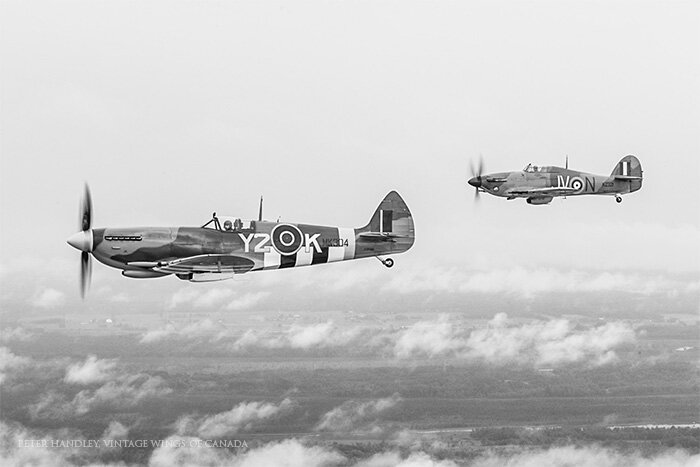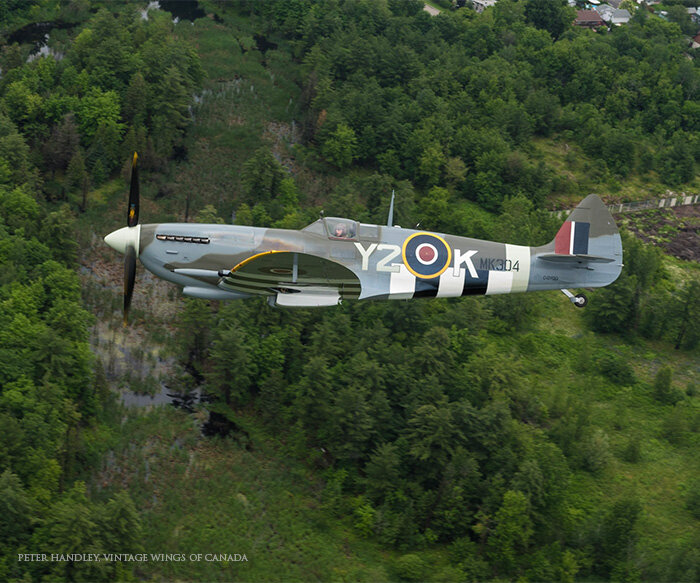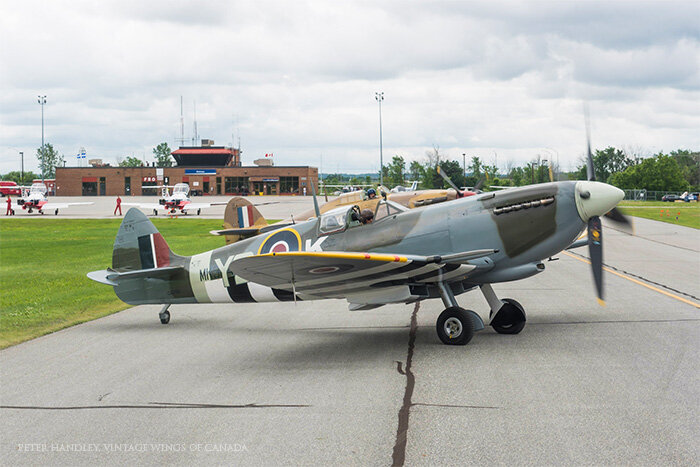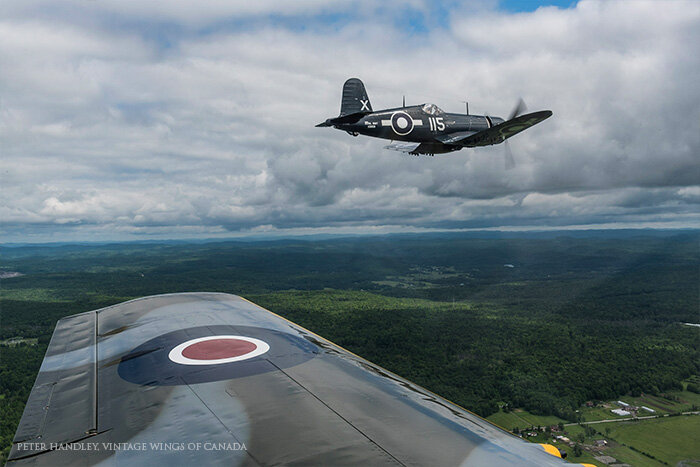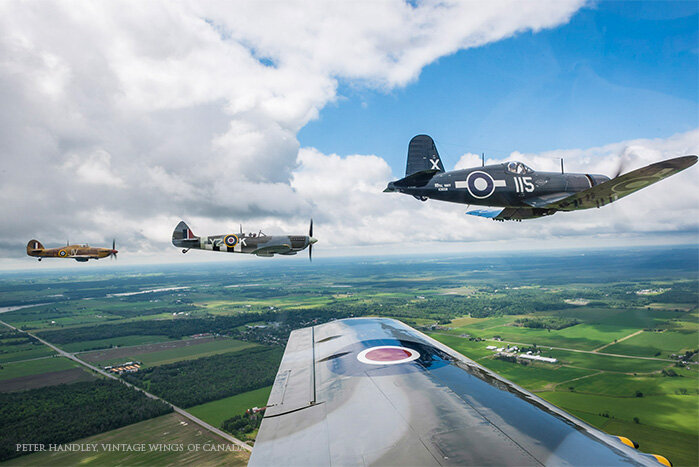GLORIOUS AND FREE
I’m certain that wherever you live on this tiny planet, it is for you the finest place imaginable. I understand that. That’s why people from Syria don’t really want to become refugees. It’s why expatriate Ethiopians pine for the hills around Addis Ababa. We are all in and of the land of our birth and life.
This year, Canada, my country, turned 150 years old. That’s nothing compared to France and Great Britain and our great neighbours to the south, but it sure got us celebrating this year. Aviation has been an integral part of Canadian history and culture for 110 years of our 150 years in existence. As such, it was fitting that aviation play a major role in Canada Day celebrations in Ottawa in this most important year. A flying cavalcade was planned over Parliament Hill, with historic and present-day assets of the Royal Canadian Air Force—from Nieuport biplanes to Spitfire to CF-18 Hornets and C-17 Globemaster. The plan included a brace of biplane fighter replicas from the First World War, followed by fighters and bombers of the Second World War and then pretty well every type of rotary and fixed wing aircraft in the RCAF fleet and then the Snowbirds demonstration team and the maple leaf festooned CF-18 Demo Hornet would make a spectacular exclamation point to end the flypast.
Vintage Wings of Canada was asked to provide some of its classic fighters to represent, along with Canadian Warplane Heritage Museum’s Lancaster and B-25 Mitchell, the outstanding contribution of Canadian aviators in the Second World War. During that global conflict, pilots and aircrew of the Royal Canadian Air Force and Royal Canadian Navy trained, fought and sacrificed in Canada and in distant lands. Many did not make it home—Bomber Command operations alone claimed the lives of over 10,000 stout-hearted Canadian boys.
We selected four of our finest aircraft for this great honour, all of which are dedicated to Canadian airmen of the Second World War. The Spitfire Mk IX, known as the Roseland Spitfire, is painted in the markings of Flight Lieutenant Arnold Roseland, 442 Squadron RCAF of Alberta, who was killed in a dog fight over Normandy not long after D-Day. The Corsair is in the markings of Lieutenant Robert Hampton Gray, Royal Canadian Navy Volunteer Reserve, and Canada’s last Victoria Cross recipient, who died while pressing home an attack on a Japanese destroyer in the final days of the Second World War. The Mustang, painted in the markings of 442 Squadron RCAF during the war, is dedicated to the two Robillard brothers, Rocky and Larry, who grew up just a few blocks west of Parliament Hill in Ottawa. These two pilots both flew with 442 Squadron and survived the war. The Hawker Hurricane Mk IV is painted in the desert camouflage of RAF squadrons operating in North Africa and is dedicated to Flight Lieutenant Donald “Bunny” McLarty, a long-time resident of Ottawa who was shot down in Egypt and managed to escape from an Italian POW camp. That’s two Canadians who died to keep Canada “glorious and free” and three Canadians who went on to make this country a better place.
For Vintage Wings of Canada, the flypast would be the first public display of the newly completed Roseland Spitfire, the first Spitfire entirely built in Canada. After a 17-year building program, the Roseland Spitfire flew for the first time last month. The Canada Day Parliament Hill Flypast was the perfect mission to debut this beauty, to honour the man it is dedicated to, to demonstrate our great respect for all that Roseland and his generation of men and women did to keep this country the finest and freest in the world.
The flypast required complex planning, timing and positioning of assets. Three Nieuport scale replicas of the Vimy Flight would lead the parade. Vintage Wings of Canada would supply four of its fighters and the Canadian Warplane Heritage Museum would follow in their Lancaster and Mitchell bombers, and then the present day RCAF fleet. Planning was precise and complex and prescribed, but only one thing could affect the outcome—the weather.
The Plan required a practice the day before and two passes on Canada Day—one just with Vintage Wings fighters executing a “missing-man” formation over Parliament followed by a join up with the cavalcade for the mass flypast. Inclement weather prevented the practice and, as it turns out, both flypasts over the 500,000 or so expected Canadians on Parliament Hill and surrounding area. We tried hard to make it happen, launching on Canada Day into rainy and cloudy weather, hoping for a break over the Hill, but aborted and landed after just 19 minutes in the air. Not to be deterred, the Vintage Wings and mass formations launched and succeeded the next day… sadly without 500,000 people to witness it.
On both occasions, Vintage Wings photographer Peter Handley was on board in the Mustang to capture the experience from our point of view and to get the first true air-to-air shots of the spectacular Roseland Spitfire. Here for your enjoyment are some of the photos from that day. Let’s ride along as Vintage Wings aircraft fly through some dramatic weather.
For an outstanding and short video about the air traffic control chess game necessary to hold, collect and queue dozens of extremely dissimilar aircraft for the flypast, click here or on the image. The planners of this event did a stellar job. Image: RCAF Facebook
July 1st—Canada Day weather is not looking good.
First to depart, Paul Kissmann wheels the High Flight Harvard down the runway, with uber-excited Peter Handley in the back. While Kissmann will position the aircraft well, the visual outcome of the entire mission rests on the skills and experience of photographer Handley. If he fails to achieve excellence, there will never be another chance like this. The outcome, however, was never in doubt with this author. Photo: André Laviolette, Vintage Wings of Canada
Pilots participating in the Canada Day flypast of Parliament Hill and who were based out of Gatineau, gather for a briefing in the board room at the Gatineau–Ottawa Executive Airport. Other commanders from aircraft based at Ottawa International were conferencing in. Out in the rainy airport ramp can be seen the CT-141 Tutors of the Canadian Forces Snowbirds. Photo: Peter Handley
Related Stories
Click on image
Back in the lounge at Vintage Wings of Canada’s hangar, the four fighter pilots go over procedures and look at the weather conditions on-line. Clockwise from left: Mike Potter, Spitfire pilot and founder of Vintage Wings of Canada; Rob Erdos, National Research Council (NRC) test pilot and Hurricane pilot; Paul Kissmann, NRC Chief Test Pilot and Corsair driver; and John Aiken, former NRC Chief Test Pilot and Mustang pilot for the flypast. Photo: Peter Handley
Four aircraft of the Michael U. Potter collection are readied for the flypast by Vintech Aero engineers Ken Wood and Paul Tremblay. Photo: Peter Handley
Mike Potter goes over his checklist prior to starting up the Roseland Spitfire Mk IX, which would be making its first public appearance as part of this flypast. Mechanics, friends and photographers know well enough to keep their distance from these warbird pilots as they prepare themselves for their flights, allowing them to be alone with their airplane and their thoughts. Interrupting them with idle chit-chat can break their concentration at a crucial period. Photo: Peter Handley
John Aitken does his pre-flight walk-around, inspecting the rudder and trim tabs of the Robillard Brothers Mustang IV. Photo: Peter Handley
Potter and Erdos follow the others onto the single 6,000-foot runway at Gatineau, while in the distance, the weather holds no promise. Photo: Peter Handley
Formation Lead Kissmann leads the group above the scudding cloud, and below the high overcast. Photo: Peter Handley
Though the weather was far from optimal, the atmospherics were gorgeous. Most air-to-air photo shoots are done early in the morning or late in the evening on sunny days to take advantage of the low angle and warm light offered by the sun near the horizon. While the results are often wonderful, the light is always the same, and the feel far from tactical. The white-grey cloud and intermittent openings on this day gave a powerful period feel to Handley’s images, reminiscent of the photographic style of true rolled-film shooters of the war. If you are familiar with Ottawa, you will note that the formation is flying southeast over Rothwell Heights just east of the facilities of the National Research Council at Blair Road. At the far right of the opening in the cloud we glimpse the Ottawa River. Photo: Peter Handley
The flat light of a rainy day makes this image feel like an early period colour photo. Montreal Road can be seen at bottom left. Photo: Peter Handley
The Roseland Spitfire in magnificent profile above the scud of an uncertain day with the Flight Lieutenant Bunny McLarty Hurricane IV holding station on far right of the “finger-four” formation. Photo: Peter Handley
When Peter Handley first looked at the previous shot, he saw something familiar in its composition and clouds that reminded him of a famous shot from the Battle of Britain. A little aging and mono-toning of the recent photo shows highlights and eerie resemblance to the following photo from that famous aerial battle. Photo: Peter Handley
The previous photo brought this famous photo immediately to mind. Supermarine Spitfire Mk Is of 610 County of Chester Squadron, based out of RAF Biggin Hill, fly over Southeast England during the Battle of Britain.
In a slow left turn, Potter and Erdos rise against a leaden sky. You can see Potter concentrating on his lead in the Corsair. Photo: Peter Handley
A gorgeous shot of Potter in the Roseland Spitfire, taken as the formation makes a right turn over lush green woodlands in Québec. Photo: Peter Handley
The formation (with the Spitfire and Hurricane moving from “finger-four” under the Mustang to “echelon-left”) passes the intersection of Boulevard Lorrain and Autoroute 50 as Kissmann heads toward home. Photo: Peter Handley
Now on Kissmann’s port wing, the three fighters follow him home over deep green Québec countryside. Photo: Peter Handley
July 2nd—Second and Successful Attempt
The cream of the crop—four of Canada’s top warbird fighter pilots, all of whom live in Ottawa. Left to right: Rob Erdos, a senior test pilot, first with the military and now the National Research Council (NRC), is also a test pilot for Skies magazine. John Aitken, former senior test pilot with the RCAF’s Aerospace Engineering Test Establishment (AETE) in Cold Lake, Alberta and Chief Test Pilot at NRC, is now Chief Pilot at Vintage Wings of Canada. Mike Potter, founder and funder of Vintage Wings of Canada and former Honorary Colonel of the Canadian Forces Snowbirds, is a high-time civilian pilot with a wide range of experience on everything from high-performance sailplanes to corporate jets to vintage aircraft and warbird fighters. Paul Kissmann, a former operational fighter pilot and squadron commander with the RCAF, was also Chief Test Pilot with AETE and is now Chief Test Pilot at NRC. Photo: Peter Handley
Prior to turning props, the pilots go over reference points on Kissmann’s Corsair for alignment during the formation. Photo: Peter Handley
Aitken watches Potter and Erdos to his left on the Vintage Wings ramp, waiting for hand signals to confirm they are ready. To fly with John Aitken is to fly with one of Canada’s finest and most respected pilots. Soft spoken, thorough, hard-working and enthusiastic, Aitken is much loved by all who fly and work with him. Photo: Peter Handley
40 years ago, a thirty-something Major John Aitken was one of Canada’s test pilots on the Northrop YF-17 evaluation program. The YF-17 was the progenitor of today’s CF-18 and was never flown operationally. Here is a rare photo of Aitken taken at Edwards AFB in October of 1977. He is chatting with two other RCAF legends—Colonel Dave Wightman (centre) and at right Al Dequetteville, future Chief of the Air Staff. Photo: Peter Handley
Mike Potter in the Spitfire goes through his run-up checklist as the four fighters line up on the taxi way prior to takeoff. Photo: Peter Handley
Now this is more like it! Kissmann in the Corsair leads the team east over the Outaouais Region north of the Ottawa River. The day before, “finger-four” formation was reversed, with Aitken and the Mustang on the left side of the formation. Today, he was on the right. Photo: Peter Handley
Potter pulls up on Aitken’s left wing. The Laurentian Mountains can be seen in the distance while sunlight begins to warm the forested landscape. Photo: Peter Handley
The formation in a gentle turn to the right. Photo: Peter Handley
Heading back west. Photo: Peter Handley, Vintage With sun dappling the Québec countryside, Potter overflies a bucolic scene reminiscent of the Normandy countryside where Y2-K once flew with her tragic pilot, Flight Lieutenant Arnold Roseland. Photo: Peter Handley
The formation on its way to take its position in the flypast of Parliament Hill. Photo: Peter Handley
The broad and flat Ottawa Valley spreads to the south as Mike Potter is lined up perfectly with Lead and Aitken. An observant eye will note that beneath the Spitfire we can see the nine white aircraft of the Snowbirds transiting to their hold location. On board one of them is Handley’s lifelong friend and fellow photographer Andy Cline, also on a flight of a lifetime. Photo: Peter Handley
Kissmann takes the formation through a series of turns designed to put the group in the right place at the right time. Photo: Peter Handley
Kissmann, Potter, Erdos and Aitken are now inbound from the east with the sun shining. Photo: Peter Handley
Just a few seconds from Parliament Hill, we can see the historic Rideau Canal (paralleled by the Rideau River at left) below with Lansdowne Park immediately below Kissmann’s nose and Ottawa University campus at bottom right. Photo: Peter Handley
From the ground on Parliament Hill. Photo: Patrick Cardinal
The formation heads home with light bouncing off the underside of Potter’s wings on the downwind of the pattern. Photo: Peter Handley
One last turn in formation. Photo: Peter Handley
Coming upriver for the overhead break. Photo: Peter Handley
A job well done. Photo: Peter Handley




















